AGI Strategic Plan
This Strategic Plan was constructed using a collaborative process that involved the full Agricultural Institute faculty, extensive research, and investment from stakeholder groups: our Advisory Board, students, and alumni. Each of these elements contributed ideas for growth, identified strengths of the program, and guided our thinking about the direction we want the Institute to take.
Our Mission Statement
The mission of the Agricultural Institute at NC State University is to provide a hands-on technical education in agriculture and related areas. The Agricultural Institute provides students access to the resources of a major land-grant institution, with programs of study leading to the Associate of Applied Science degree. The combination of general education and technical skills helps students develop both personally and professionally and prepares them to be productive leaders in society with the ability to adapt to an ever-changing agricultural sector.
Vision Statement
The Agricultural Institute will absolutely, positively identify as the #1 Agricultural AAS degree in the United States.
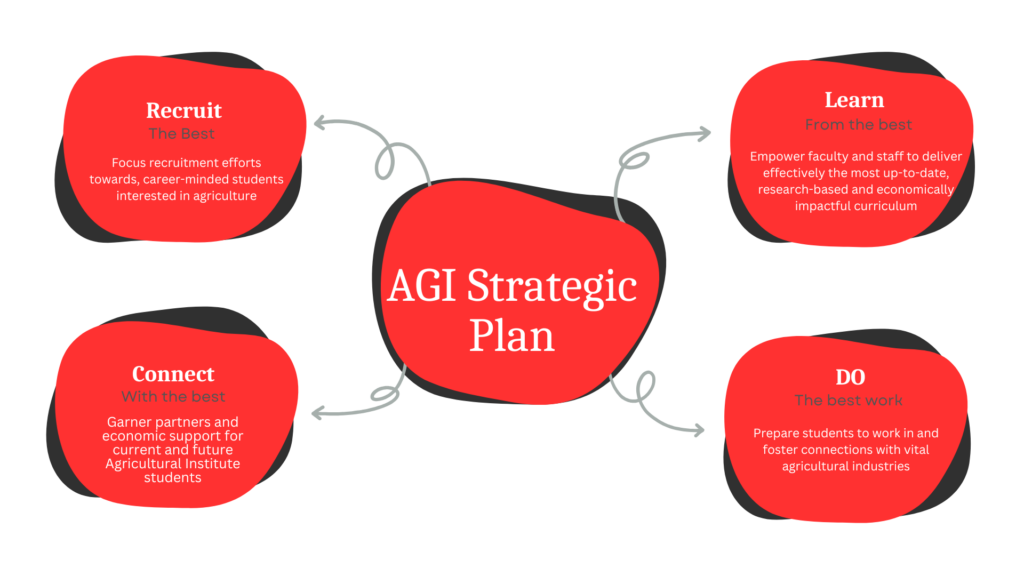
Goal #1
Focus recruitment efforts towards career-minded students interested in agriculture
This goal has three prongs: availability of education, enrollment, and clear and consistent messaging. We believe that these three areas will enable our program to continue to serve the populations of students we have recruited and served in the past, but also to expand our student population in both numbers and variety.
The Agricultural Institute has a long and successful history of graduating students who are prepared to contribute to the agricultural industry in North Carolina and across the country. We will continue to recruit students from those areas and communities with which we have had success, and for whom we serve a critical role. We also need to begin to branch out and connect with new and varied populations of students.
Recruiting students who have no familial or educational background in agriculture requires a different set of strategies, which include showcasing the career opportunities that a degree in agriculture offers and highlighting the tight-knit community the students will experience while at the Institute (Setterbo et al., 2017).
Retooling our recruitment strategy to include more innovative, targeted efforts, while retaining those methods that have been most successful in the past, will help strengthen and expand the Agricultural Institute’s student population and thus strengthen the agricultural field in North Carolina and beyond.
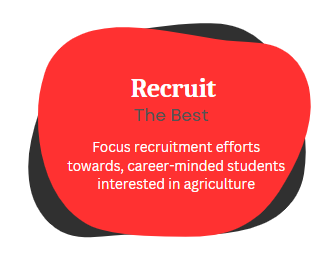
Objectives
- Leverage connections with high school ag teachers, guidance counselors, current students, alumni, extension, community partners, and faculty to reach the largest possible number of prospective students
- Develop a clear recruitment message and identify factors important to different populations of prospective students to adapt the message effectively
- Recruit a varied student population and ensure effective support of those students within the program
- Continue recruiting within sectors where we have had success while identifying and targeting new ones
- Raise awareness of our program by promoting favorable program comparisons, awards and recognitions, faculty achievements, and student opportunities including internships and study-abroad programs
Goal #2
Empower faculty and staff to deliver effectively the most up-to-date, research-based and economically impactful curriculum
This wide-reaching goal encompasses academic programs, student-life experiences, professional development, and program comparisons and metrics. We understand that it is the interplay between these areas that creates the possibility for a truly excellent education for our students.
The Agricultural Institute offers a unique and special opportunity for students: it is a small program that offers hands-on learning by faculty who know each student, while also providing students with all the benefits of the larger NC State campus. However, in part because of the special nature of the program, students in the Agricultural Institute also face unique challenges when they arrive on the NC State campus. Positive student-faculty relationships, small class sizes and peer interaction are important for two-year students on a four-year campus (Pichon, 2016). We endeavor to focus on these areas and analyze other aspects of student life unique to our student population.
The best models for faculty development include systematic, long-term programs (Borda et al., 2020); among other benefits, comprehensive faculty development programs can significantly increase student evaluations of courses (Roberts et al., 2019). Because the faculty that teach in the Agricultural Institute are situated in home departments across the College of Agriculture and Life Sciences, there are inherent opportunities for interdisciplinary connections that can only benefit faculty and the students we serve. Peer observations can offer a constructive and low-stakes method for improving teacher effectiveness (Sparks, 1986), as well as to foster community among faculty and improve pedagogical development (Thomas et al., 2014).
We have identified five peer institutions; we intend to identify and compare specific metrics to ensure we are meeting and exceeding industry expectations for graduates.
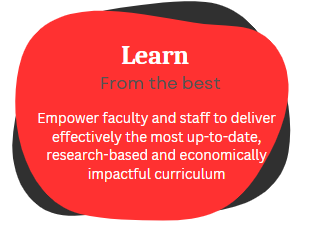
Objectives
- Conduct programmatic analysis across departments to facilitate a cohesive curriculum that meets industry and student needs
- Deliver applicable, hands-on learning
- Identify and utilize resources within and outside the university to promote faculty professional development
- Establish processes for evaluation and advancement within AGI core faculty
- Connect faculty within AGI to cultivate collaboration and pedagogical advancement
Goal #3
Prepare students to work in and foster connections with vital agricultural industries
Preparing students for careers in agriculture requires both a hands-on curriculum and professional preparation; the Agricultural Institute offers these to students, and we look forward to improving and enhancing both in the future.
Soft skills and hands-on experiences like internships are the most important factors employers consider (Finch et al., 2013), even above core industry knowledge. In a recent survey of agricultural employers, soft skills made up nine of the top ten skills employers look for (Freeman et al., 2021). Helping students develop these skills, then, needs to be an integral part of any agricultural program.
The combination of lectures and hands-on experiences leads to the best learning outcomes for students (Wells et al., 2019), and students believe that relevant work experience is the most important factor in future career success (Feldpausch et al., 2019). Internships offer the opportunity to acquire hands-on experience in a real work setting.
To be successful post-graduation, students need to have had the preparation during their education, but they also need to begin to develop their professional network. Having a wide range of contacts, both within and outside students’ chosen fields as well as closely or more loosely connected with those graduates, ensures the greatest success in the job search of recent graduates (Barbulescu, 2015).
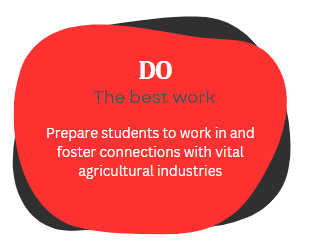
Objectives
- Prepare students for the workplace by offering opportunities for professional development
- Provide opportunities for connections between students and alumni, advisory board, industry partners, and employer market
- Improve student retention by fostering an inclusive and supportive environment, especially for first-year students
- Providing opportunities for students to be involved in national and international agriculture activities
- Offer relevant certification training and testing opportunities and explore industry support
Goal #4
Garner partners and economic support for current and future Agricultural Institute students
Funding is instrumental to any institutional change. While state-appropriated funding remains key to the efficiency of public institutions of higher education (Sav, 2017), finding and securing other forms of revenue remains important to the success of the Agricultural Institute.
The agricultural industry in North Carolina offers consistent support for programs like ours and depends on graduates from two-year programs to fill their workforce (King et al., 2011); reinforcing existing connections and identifying new partners will be key to the success of the initiatives outlined in this plan. Part of this process has to include promoting the opportunities for students, faculty excellence, and strong community support the Agricultural Institute has.
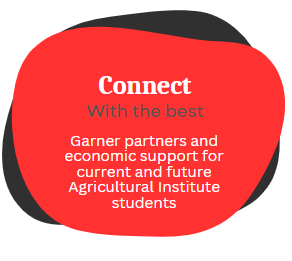
Objectives
- Gather information from key stakeholder groups to improve programs and guide resource allocation
- Compare metrics, including ROI, enrollment, majors, retention, instructor longevity, instructor accomplishments, to peer institutions
- Create communication structure for grants and funding within AGI to streamline processes and establish cohesive strategy
- Partner with outside units to broaden funding opportunities and increase grant success
References
Barbulescu, R. (2015). The strength of many kinds of ties: Unpacking the role of social contacts across stages of the job search process. Organization Science, 26(4), 1040-1058.
Borda, E., Schumacher, E., Hanley, D., Geary, E., Warren, S., Ipsen, C., & Stredicke, L. (2020). Initial implementation of active learning strategies in large, lecture STEM courses: Lessons learned from a multi-institutional, interdisciplinary STEM faculty development program. International Journal of STEM Education, 7(1), 1-18.
Feldpausch, J. A., Bir, C. L., Widmar, N. J. O., Zuelly, S. M., & Richert, B. T. (2019). Agricultural student perceptions of career success factors: Ranking attributes of collegiate experiences. Journal of Agricultural Education, 60(1), 234-267.
Finch, D. J, Hamilton, L. K., Baldwin, R., & Zehner, M. (2013). An exploratory study of factors affecting undergraduate employability. Education + Training, 55(7), 681-704.
Freeman, S., Culbertson, A., Rocca, S., Vaughn, R., Standridge, C., Flores, J., and Henson, M. (2021). Ag. skills survey: Skills sought by employers in the agricultural industry. Golden Slate: The Official Newsletter of the California Agricultural Teachers’ Association. Retrieved from https://catagoldenslate.wordpress.com/2021/07/16/ag-skills-survey-skills-sought-by-employers-in-the-agricultural-industry/
King, D., Duncan, D. W., & Mykerezi, P. (2011). Strengths and weaknesses of land-grant two-year technical agriculture programs as perceived by program directors. NACTA Journal, 55(1), 38-43.
Pichon, H. W. (2016). Developing a sense of belonging in the classroom: Community college students taking courses on a four-year college campus. Community College Journal of Research and Practice, 40(1), 47-59.
Roberts, T. G., Colclasure, B., LaRose, S., Turner, E., & Wysocki, A. (2019). An examination of changes in student course evaluations of CALS faculty after participating in a faculty development program. Journal of Agricultural Education, 60(4), 212.
Sav, G. T. (2017). Efficiency evaluations of U.S. public higher education and effects of state funding and pell grants: Panel data estimates using two stage data envelopment analysis, 2004-2013 academic years. Journal of Education Finance, 42(4), 357–385.
Setterbo, K., Akers, C., Tarpley, T., & Kennedy, L. (2017). Going against the grain: Recruiting atypical students into a college of agriculture. NACTA Journal, 61(1), 46-51.
Sparks, G. M. (1986). The effectiveness of alternative training activities in changing teaching practices. American Educational Research Journal, 23(2), 217-225.
Thomas, S., Chie, Q. T., Abraham, M., Jalarajan Raj, S., & Beh, L. (2014). A qualitative review of literature on peer review of teaching in higher education: An application of the SWOT framework. Review of Educational Research, 84(1), 112-159.
Wells, K., VanLeeuwen, D., Seevers, B., & White, L. (2019). Impact of traditional lecture and hands-on learning on students’ knowledge gain in animal science courses. NACTA Journal, 63(2).